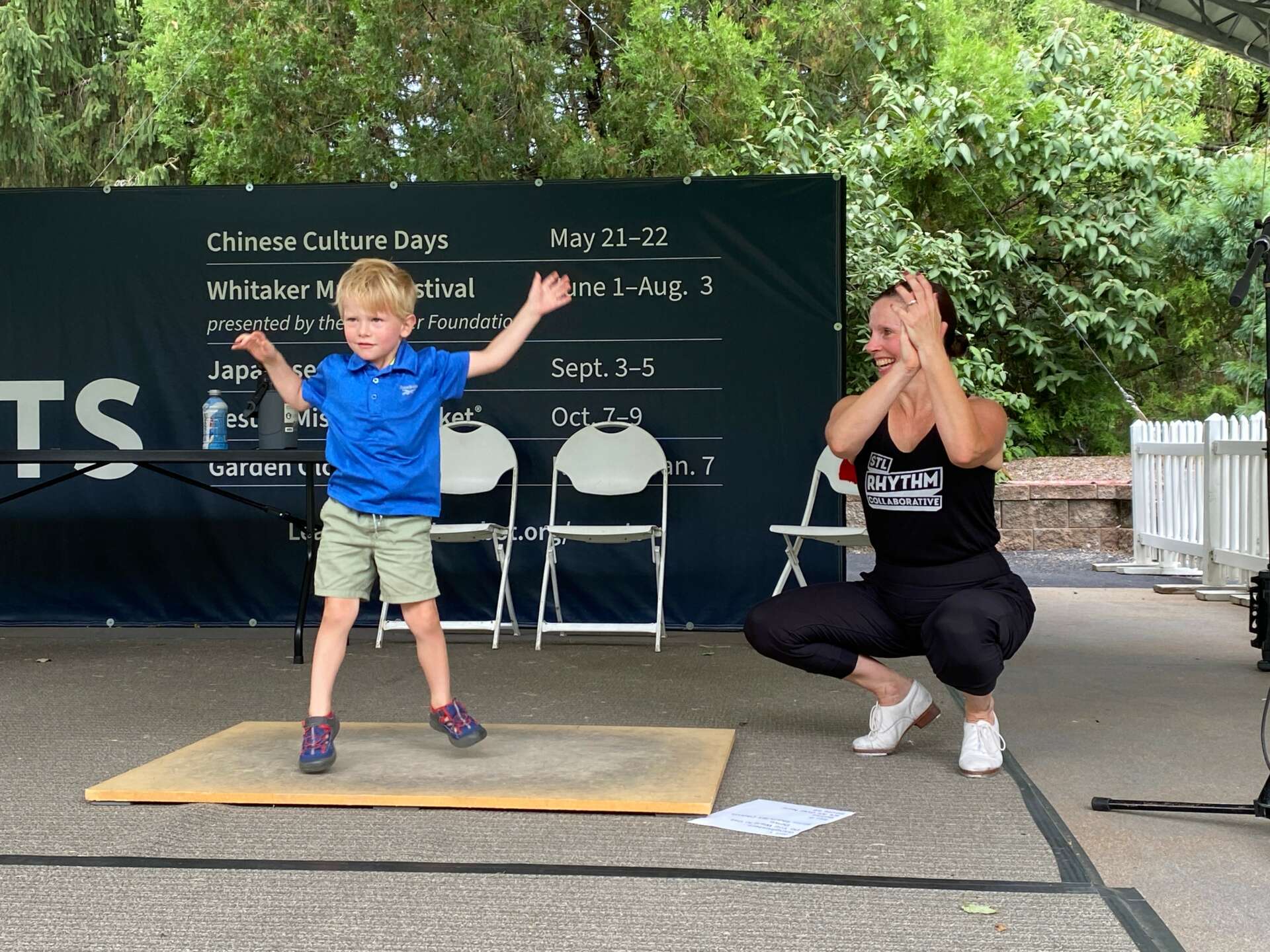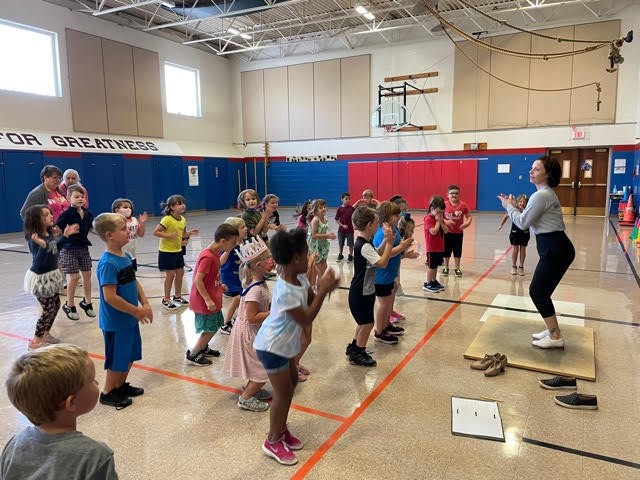We recently connected with Maria Majors and have shared our conversation below.
Maria, looking forward to hearing all of your stories today. Can you tell us about a time that your work has been misunderstood? Why do you think it happened and did any interesting insights emerge from the experience?
STL Rhythm Collaborative’s professional dance ensemble, moSTLy TAP, is just as it sounds…a tap dance company that presents mostly tap dancing, often with our ensemble of musicians, moSTLy JAZZ. It’s our goal to boost enthusiasm for tap dance and jazz music in St. Louis through the presentation of our live music and tap dance collaborations. We are delighted when individuals approach us after performances and say things like, “I’ve never seen tap dancing like that before,” or “I didn’t know tap dancing could be its own instrument,” and, “Your dancing compliments the music so well.” It means that our audience hears us and understands the connection of tap dance to music. Tap dance IS music.
Now to answer your question: Yes, I often feel our work is mischaracterized because of the common misconceptions that the general public has about tap dance. I sometimes feel that can be our biggest challenge when we’re looking to book shows or collaborate with other arts organizations. In general, people don’t really understand what we have to offer until they come experience it for themselves. For the most part, it has been my experience that what the general public envisions when you say “tap dance” is not an accurate portrayal of the form.
Many artists can relate to the hundreds of cold emails and calling one does to promote their work in an attempt to get it in front of new audiences. A couple of years ago, I contacted a music venue in St. Louis explaining who we were and what we do. I was very happy to get a reply but puzzled by the response. They thanked me for contacting them, but went on to say they didn’t feel we’d be a good fit because their venue presented more of a “listening experience” to their audience. Isn’t that what tap dancing is? While presentation and performance of tap dancing can be visually stimulating, why do we have metal taps on our shoes if we are not offering a “listening experience” as well?



Maria, love having you share your insights with us. Before we ask you more questions, maybe you can take a moment to introduce yourself to our readers who might have missed our earlier conversations?
To summarize, I started dancing at a very young age and it’s always been something I couldn’t live without. I moved to NYC after high school to pursue my professional dance career and was blessed to tour with Manhattan Tap, under the direction of Heather Cornell. I returned to the Midwest and began teaching dance all over St. Louis. I attended the annual St. Louis Tap Festival every year and served on its Board of Directors alongside the late Professor Robert L. Reed. I started my performance company, moSTLy TAP, in 2017 with former students and colleagues. In addition to performing all over the area, we started offering classes and workshops. As a result, there was growing interest amongst young artists to have more opportunities to study tap dance and work in a more collaborative setting. During the pandemic, I developed what is now our performing arts education programs through my nonprofit organization, STL Rhythm Collaborative. Our mission is to provide collaborative dance and music programming opportunities that connect, educate, and inspire artists of all ages through rhythm.
As a young nonprofit (founded in 2020), we really do a LOT. Our Community Engagement Program offers free monthly events for all ages that include music and dance jam sessions, history/footage nights, and other gatherings. Our Education Program offers in-school programs, weekly classes, summer camps, a Pre-Professional Student Program for young artists, and our Annual STL Rhythm Fest, which brings internationally known artists to St. Louis for master classes, panel discussions, and history study…all open to the public. Finally, our Professional Program houses our professional performance ensembles, moSTLy TAP and moSTLy JAZZ, who present live music and dance collaborations through out the St. Louis area.
We often collaborate with other area nonprofits in an effort to support their missions as well. We regularly work with The Salvation Army, and CommUNITY Arts STL.
The team at STL Rhythm Collaborative is comprised of our small but mighty Board of Directors, myself (Maria Majors), the professional dancers of moSTLy TAP, and musicians of moSTLy JAZZ, who are also experienced dance and music educators. The artists often go above and beyond, volunteering much of their time toward bettering our education program, whether that’s in the classroom or arts administration.
While we have an amazing faculty with experience in teaching various styles of dance and genres of music, we are the only performing arts nonprofit in the area that places such emphasis on rhythm and tap dance. We prioritize creating an environment where EVERYONE feels welcome and seen! We are also proud to be one of few dance presenters in the area that incorporates live music into our dance productions.
We currently rent spaces throughout the St. Louis area and utilize the support of various arts organizations to host our programs. It is my dream have a home for STL Rhythm Collaborative one day soon; a place bustling with music, rhythm, and movement, where folks of all ages are free to be themselves, to learn and explore the creative process. I’m so grateful we are growing so quickly, and I’m ecstatic about what lies ahead. In just the next couple of years, we’ll be employing positions in arts administration, dance and music faculty, professional performance, technical design, set design, and management positions. I’m very proud to be contributing to the growth and longevity of our arts community by providing opportunities for artists to live and work in St. Louis.
We certainly need support to help us realize this dream, there are many ways folks can get involved. If your readers are interested in learning more, I’m always grateful for the interest and happy to share more information: [email protected]



Is there mission driving your creative journey?
As a result of my early experience in seeking professional opportunities for myself, the ultimate goal or mission driving my journey is to create professional and educational arts opportunities through my organization, STL Rhythm Collaborative, that support and compliment our St. Louis arts ecosystem. I want aspiring artists to feel like they could move TO St. Louis for professional opportunities. I want young local students have the option for a remarkable professional career right here while staying close to their families, if that’s what they choose.
It was around my teen years that I became much more serious about realizing my dream of becoming a professional dancer.
I chose to move to New York to pursue my career because opportunities in St. Louis to support myself financially as a professional performer were very few. In New York, I could be inspired by and study with leading professionals in their field. There were more choices available to me. Plus, in cities like New York, it’s quite common to be walking through town and experience artists performing right there on the street. Individuals are much more immersed in the creative experience in their everyday life and are more apt to support the arts as a result.
Things have changed in the St. Louis arts community a lot since those days. There are more local professional dance companies presenting new and thought provoking work and there are a variety of arts organizations that work tirelessly to create a more viable landscape for arts and culture in St. Louis. STL Rhythm Collaborative is a unique compliment, providing professional and recreational opportunities to study and present music and dance together, with a focus on the art of tap dance.


What can society do to ensure an environment that’s helpful to artists and creatives?
I would answer with two thoughts; 1. be more observant and 2. be an active participant.
1. Naturally, you can expect to find art in places like a museum, gallery exhibit, concert, and live shows, but art and creativity are abundant in our daily lives. Unfortunately, in the hustle and bustle of our routines, much of it goes unnoticed and under appreciated. It’s apparent in the tv shows, movies, and music we stream, but also in the architecture of the buildings we work in and the marketing of products and services. It can also be less tangible. It’s in the way we find creative solutions to obstacles we face. It’s in the tools educators use to reach each student. When we are more observant of how art impacts our daily lives, we have a greater appreciation for the work of those who have dedicated their lives to their craft.
2. Supporting the arts community is imperative to its success. There are many different ways you can do this. If you’re on social media, like and share the artwork that moves you. Ask friends what artists or groups they follow. Join mailing lists so you don’t miss any events or other opportunities. Those are all easy and FREE! If you don’t know what’s going on in the local arts community, do an online search. Its so easy to find the information you’re looking for nowadays. Purchase tickets to see a live show and bring a friend. Make a donation. Most individual artists and organizations have websites with a “support” page that explains what your donation will help achieve. If you can donate $5, DO IT. Any amount is valuable.
Contact Info:
- Website: www.stlrhythmcollaborative.org
- Instagram: @stlrhythmcollaborative
- Facebook: @stlrhythmcollaborative
- Linkedin: STL Rhythm Collaborative
Image Credits
Clarence Alford STL Rhythm Collaborative


